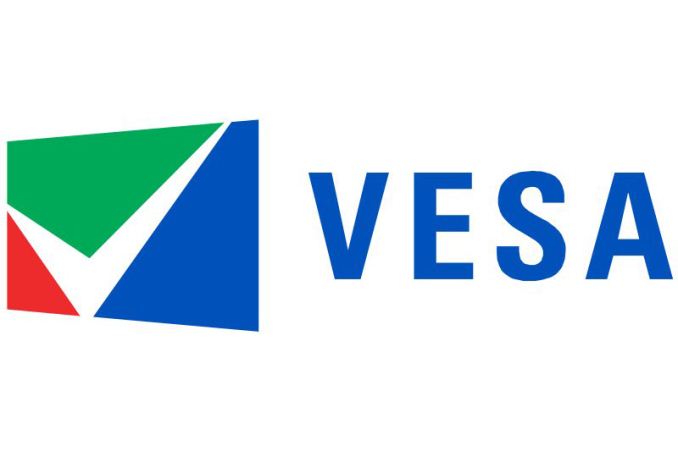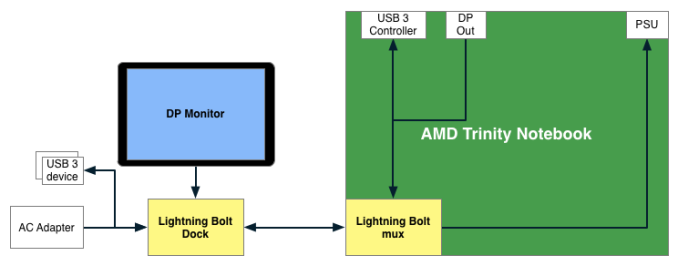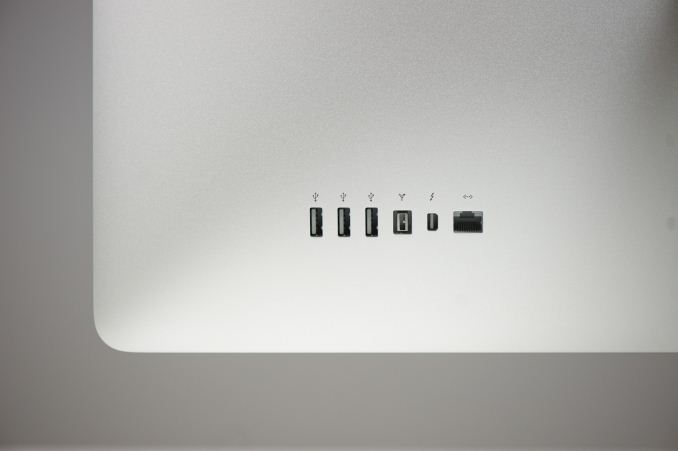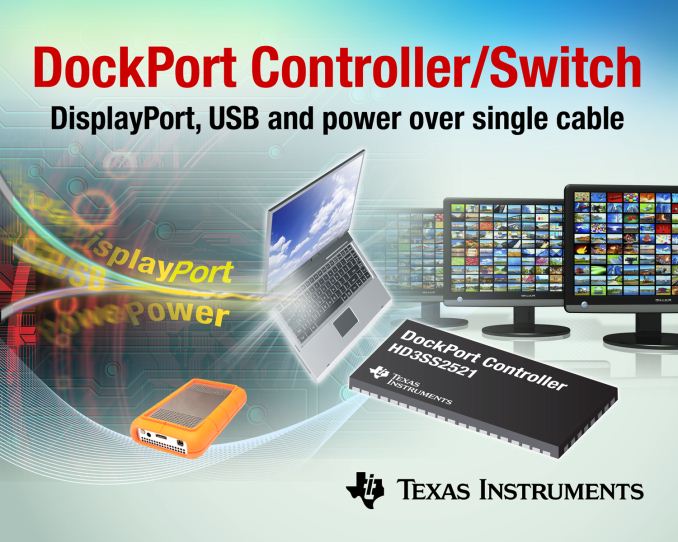AMD/TI's DockPort Adopted As Official Extension to DisplayPort Standard
by Ryan Smith on January 7, 2014 9:40 AM EST- Posted in
- Laptops
- AMD
- TI
- DisplayPort
- Thunderbolt
- Lightning Bolt
- Trade Shows
- VESA

Shortly after the launch of Intel’s Thunderbolt interface in 2011, there was a great deal of discussion to be had in several camps over what the future of data and display interfaces may hold. Thunderbolt was a very intriguing interface, not only on a raw bandwidth basis but also on the basis of being able to reduce cable clutter by bringing data and display connectivity to a single small Mini DisplayPort connection. But with those capabilities came concern over the fact that Intel held exclusive control over the technology, and that its PCI-Express roots made the product more complex/expensive than what some manufacturers and system builders were willing to support.
The end result was that a few different ideas were floated as potential Thunderbolt competitors. AMD’s Lightning Bolt proposal ended up being the frontrunner in this field, proposing a very Thunderbolt-like connection that would have USB 3.0 and power routed alongside DisplayPort, rather than Thunderbolt’s PCI-Express plus DisplayPort. However since AMD’s concept demo two years ago at CES 2012 we’ve heard very little about Lightning Bolt. Until today, that is.

AMD's CES 2012 Lightning Bolt Concept
At CES 2014 the Video Electronics Standards Association (VESA) is announcing that Lightning Bolt, now operating under the name DockPort, is being adopted as an official extension to DisplayPort. This move effectively promotes DockPort from a 3rd party standard riding on top of DisplayPort to a 1st party standard that although not required for DisplayPort compliance, now has the backing of the entire VESA rather than just AMD and Texas Instruments. Equally important, like DisplayPort itself DockPort is going to be royalty free, opening the door for device makers and chip makers alike to implement it at-cost, without paying additional fees.
With DockPort the VESA is initially targeting a slightly different series of use cases than what Intel and Apple have done with Thunderbolt, both for technical and pragmatic reasons. Whereas Thunderbolt is being used to supersede USB 3.0 in some cases, as DockPort is based on USB 3.0 there’s little need to supersede USB 3.0 as far as data connectivity is concerned. Rather DockPort will be focused on single-cable connectivity – and as implied by the DockPort name – as a docking interface for tablets and laptops. The latter in particular owing to the fact that DockPort carries power alongside its data and display components.
As we’ve already seen with Thunderbolt products such as Apple’s Thunderbolt Display, there are definitely some good arguments to be had for offering a single combined data/display interface, as the continued shift from desktops to laptops has made monitors as docking stations an increasingly attractive option. Furthermore because DockPort provides power as well data, it should be possible to surpass Thunderbolt here and go truly single-cable on tablets and laptops, with the DockPort providing everything a laptop needs. However it remains unclear just how much power the standard will be able to provide to host devices, and consequently how big of a device can be powered through DockPort.

DockPort's potential: monitors as laptop docks
Meanwhile on the technical side of matters, while there isn’t a final specification to have in hand quite yet (finalization is expected in the second quarter), DockPort looks very similar to AMD’s initial Lightning Bolt proposal. This means we’re looking at DisplayPort 1.2 with USB data multiplexed into the connection. DisplayPort 1.2 tops out at effective data rate of 17.2Gbps, with the DisplayPort display stream and the USB data stream sharing the connection. At the same time while DockPort cables won’t be identical to DisplayPort cables, the VESA has confirmed that DockPort will offer passive cables, allowing for DockPort cabling to be cheaper than the relatively expensive active cables that Thunderbolt requires.
From a functionality perspective, due of the muxing of DisplayPort and USB the amount of bandwidth available to data devices will depend on in part the amount of bandwidth leftover after connected displays have consumed their share. Practically speaking this means that we expect AMD’s earlier claims to remain true, and that DockPort won’t be able to quite keep up with a native USB 3.0 connection. Meanwhile because this is USB based, this also means that manufacturers will be able to include just about any type of USB peripheral in their docks/monitors, including USB audio controllers, USB based NICs, and USB hubs, for all the benefits and drawbacks USB provides.
Meanwhile in an interesting twist, due to the drawn out development of DockPort, the first DockPort controller is already out ahead of the specification itself. TI’s HD3SS2521 controller was unveiled back in 2013 when AMD and TI were still going it alone on DockPort, and is being used as the basis of the final standard. Until the standard is in hand it’s not clear quite how quickly DockPort devices will be available, but with TI already having a controller on the market the turnaround time should be much shorter than most other VESA standards (where the specification has come first and the silicon second).
As for how widely DockPort will be adopted, it’s going to be a wait-and-see affair. Thunderbolt has seen little success outside of the Mac realm, and while the idea behind DockPort/Thunderbolt is very sound and useful, this doesn’t guarantee its adoption. Outright inertia carries a lot of weight in the PC industry and in the meantime plain DisplayPort is still relatively uncommon on laptops and mobile devices, especially outside of workstation grade laptops.
On the other hand, having an open standard opens the doors to ultimately having multiple vendors with competing DockPort controllers, which offers the potential to keep controller costs closely in check. All the while the aforementioned passive cabling will bring down total costs even further. The use of USB instead of PCI-Express should also make DockPort more Windows-friendly than Thunderbolt, as USB is already hot-plug friendly as opposed to Thunderbolt requiring an additional layer of drivers to make PCI-Express behave properly with hot-plugging.
Wrapping things up, AMD and TI will be showing off their initial work on DockPort at CES 2014, showcasing a version of the AMD Discovery concept tablet with DockPort functionality. Otherwise we should have more launch details on DockPort once the specification is finalized next quarter.
Source: VESA











27 Comments
View All Comments
Hrel - Wednesday, January 8, 2014 - link
Great, I'm glad were still able to avoid the trap of proprietary licensing. It's an industry killer, which makes me upset Intel, like the old Dell, keeps trying to do it.***Someone PLEASE answer this for me!
WHY does display port even exist? The last time I looked at the HDMI spec it supported bandwidth FAR beyond what even 4K and 7.1 surround sound could saturate. Furthermore taking the display out of this new DockPort standard would increase transfer speeds, which I'm far more interested in than consolidating 2 cables into 1.
My preferred solution would be HDMI for audio/video and DockPort for accessories, like hard drives and mice and things. But I guess that depends on the answer I receive about HDMI and DP.
Does HDMI have licensing fees for vendor's to use it?
repoman27 - Wednesday, January 8, 2014 - link
HDMI was created for the consumer electronics industry to to carry the then common DVI TMDS signal along with multichannel audio and a healthy amount of DRM over a single cable with compact, consumer friendly, friction-fit connectors, and yes, it does indeed require licensing. The original target was 1080p60 HDTV and easy adaptability, so the early versions of HDMI used the exact same video signal as single-link DVI, and thus had the same bandwidth limitations (1920x1200, 24 bpp, 60 Hz max). Later versions increased the maximum clock rate enabling support for higher resolutions, higher color depths and 3D formats, added Ethernet and audio return channels, etc. However, even HDMI 1.4b (the most recent version to actually be found in shipping devices at this point) only supports resolutions up to 3840x2160p30 at 24 bpp. The recently released HDMI 2.0 spec bumps the maximum clock rate up once again to support up to 18 Gbit/s of bandwidth, which is on par with the 17.28 Gbit/s of DisplayPort 1.2, and is enough to handle 4K UHD resolutions at 60 Hz.DisplayPort was created to replace DVI and VGA in the PC space, was designed around a packet based protocol, and is royalty free. Even the original version offered 8.64 Gbit/s of bandwidth, or slightly more than the 8.16 Gbit/s of HDMI 1.3/1.4. DP 1.2 doubled that to 17.28 Gbit/s and (thanks to AMD) has been shipping for 3 years now. DisplayPort has always been more focused on PC display features, such as supporting higher resolutions and multiple display streams over a single port / cable, and has been slower to adopt more consumer (read television) oriented features. By using a packet based protocol, DisplayPort frees itself from requiring a separate TMDS timing source for each display output. This is why AMD GPUs can only drive 2 displays using HDMI / DVI, but can manage 6 via DisplayPort. For many years now, all Intel and AMD GPUs have featured flexible digital display output ports that can support either DisplayPort or TMDS signaling. NVIDIA has been a little slow to join the DP bandwagon for some reason, but I believe Kepler supports DP 1.2 across the board.
Taking the display out of DockPort would leave nothing but USB.
LordOfTheBoired - Wednesday, January 8, 2014 - link
DisplayPort exists because DVI/HDMI is a crap standard. It was never really designed to drive LCD monitors, and has a lot of CRT-specific legacy CRAP embedded in the signal that any monitor being driven by DVI or HDMI has to scrape away before it can reconstruct the frame. There are apparently also issues with the actual transmission spec that make it(in either form) ill-suited for long runs and require a solid chunk of logic in the display to reconstruct a horribly malformed signal.Higher resolutions and color depths are making this a bigger problem every day, and it's my understanding that a lot of people are surprised they managed to get UHD working on the existing HDMI cable in the first place.
azazel1024 - Wednesday, January 8, 2014 - link
I agree with the replies about being a dumb way to go about it.With Displayport 1.3 they should have just changed connectors to support at least 1 full USB3 channel, or better yes, 1 full USB3.1 channel, since that is neigh, plus full display port 1.3.
I am much less familar with HDMI, but what hurdles would there be to implementing it through that? It seems like the connectors have a lot more signaling wires (I could obviously be mistaken). What about simply muxing or carrying USB3 over HDMI?
HDMI is significantly more common than display port on both displays, TVs and on laptops/video cards. I know HDMI can already carry ethernet (I assume it is 100Mbps, not 1Gbps though).
I guess due to commonality, I would be much more interested if it was HDMI, with Gigabit ethernet PLUS USB3.0 carried over the same wire, through the same port. Then you have options for full size, mini and micro connectors to suit your needs.
repoman27 - Wednesday, January 8, 2014 - link
It's a little trickier to do it with HDMI, but MHL essentially manages to do it the other way around (muxing HDMI over a USB port).DisplayPort is the far more capable spec, and is actually ubiquitous in the PC space, although sadly OEMs seem to enjoy hiding it from end users whenever possible.
The problem with combining HDMI, GbE, USB 3.0 and power delivery all on the same cable becomes evident when you add up the number of signaling pairs you'd need to to carry all those protocols at the same time. (4 for the TMDS data and clock for HDMI, 4 for 1000BASE-T style Ethernet, 1 for USB 2.0, 2 for SuperSpeed USB...) We're at 22 conductors before we even get to power, ground and shielding. That's going to be one stout cable, and the connectors will hardly be "micro", not to mention that the interference potential of having that many signals running at totally different frequencies in the same cable is huge. Muxing the signals might reduce pin / conductor count, but also gets messy real quick.
This is exactly why Thunderbolt was born. DisplayPort, Ethernet, PCIe: they're all just packets. Just create one high-speed dual carriageway, dump them all on there and send them on their way. Muxing at the packet level is the way to go. Unfortunately, with Thunderbolt, it's also the expensive, proprietary, Intel only way to go.
GhostBirdofPrey - Thursday, January 23, 2014 - link
I don't understand why they didn't redesign the connector to be a superset of the current standard miniDP connector. The cable had to be redesigned so they might as well have redone the connector then they would have been able to add a couple extra datalines for the USB to reduce the need for multiplexing (and also possibly more power lines for increased amperage to power and charge the connected device)Also as a superset it would be similar to how USB 3.0 got a redesigned connector, more connections allows more throughput but by containing the old connector everything is backwards compatible still.
===
Still display+usb+power in one cable is something I have wanted as a standard for a long time now.
POPAJOE - Monday, May 19, 2014 - link
I would like to say thanks to them and could we get a firewrie adapter out of this good new's we hope; this is and would be greatly need by so many.;popajoe thanks you so much's :